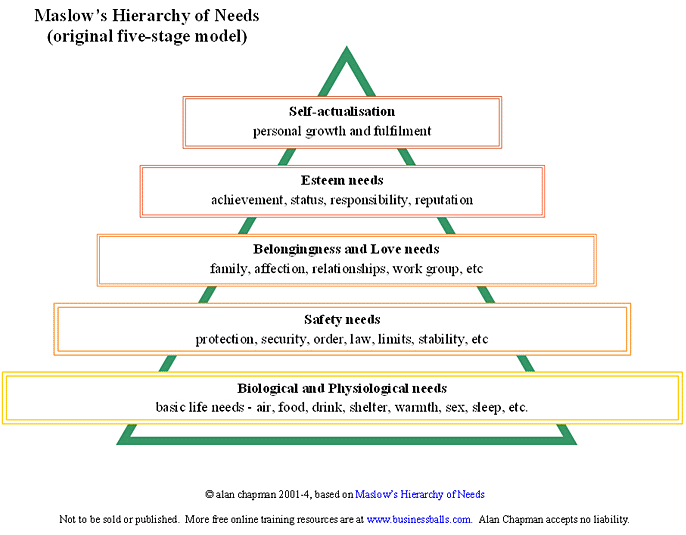Needs theory remains valid today for understanding human motivation, management training, and personal development. Indeed, Maslow's ideas surrounding the Hierarchy of Needs concerning the responsibility of employers to provide a workplace environment that encourages and enables employees to fulfil their own unique potential (self-actualization) are today more relevant than ever. Abraham Maslow's book Motivation and Personality, published in 1954 (second edition 1970) introduced the Hierarchy of Needs, and Maslow extended his ideas in other work, notably his later book Toward A Psychology Of Being, a significant and relevant commentary, which has been revised in recent times by Richard Lowry, who is in his own right a leading academic in the field of motivational psychology.
Abraham Maslow was born in New York in 1908 and died in 1970, although various publications appear in Maslow's name in later years. Maslow's PhD in psychology in 1934 at the University of Wisconsin formed the basis of his motivational research, initially studying rhesus monkeys. Maslow later moved to New York's Brooklyn College.
The Maslow's Hierarchy of Needs five-stage model below (structure and terminology - not the precise pyramid diagram itself) is clearly and directly attributable to Maslow; later versions of the theory with added motivational stages are not so clearly attributable to Maslow. These extended models have instead been inferred by others from Maslow's work. Specifically Maslow refers to the needs Cognitive, Aesthetic and Transcendence (subsequently shown as distinct needs levels in some interpretations of his theory) as additional aspects of motivation, but not as distinct levels in the Hierarchy of Needs.
Where Maslow's Hierarchy of Needs is shown with more than five levels these models have been extended through interpretation of Maslow's work by other people. These augmented models and diagrams are shown as the adapted seven and eight-stage Hierarchy of Needs pyramid diagrams and models below.
There have been very many interpretations of Maslow's Hierarchy of Needs in the form of pyramid diagrams. The diagrams on this page are my own interpretations and are not offered as Maslow's original work. Interestingly in Maslow's book Motivation and Personality, which first introduced the Hierarchy of Needs, there is not a pyramid to be seen.
Free Hierarchy of Needs diagrams in pdf and doc formats similar to the image below are available from this page.
(N.B. The word Actualization/Actualisation can be spelt either way. Z is preferred in American English. S is preferred in UK English. Both forms are used in this page to enable keyword searching for either spelling via search engines.)
Maslow's Hierarchy of Needs
Each of us is motivated by needs. Our most basic needs are inborn, having evolved over tens of thousands of years. Abraham Maslow's Hierarchy of Needs helps to explain how these needs motivate us all.Maslow's Hierarchy of Needs states that we must satisfy each need in turn, starting with the first, which deals with the most obvious needs for survival itself.
Only when the lower order needs of physical and emotional well-being are satisfied are we concerned with the higher order needs of influence and personal development.
Conversely, if the things that satisfy our lower order needs are swept away, we are no longer concerned about the maintenance of our higher order needs.
Maslow's original Hierarchy of Needs model was developed between 1943-1954, and first widely published in Motivation and Personality in 1954. At this time the Hierarchy of Needs model comprised five needs. This original version remains for most people the definitive Hierarchy of Needs.
http://www.businessballs.com/maslow.htm



No comments:
Post a Comment